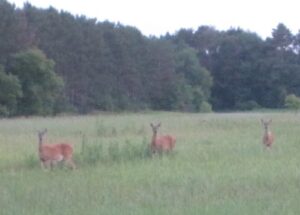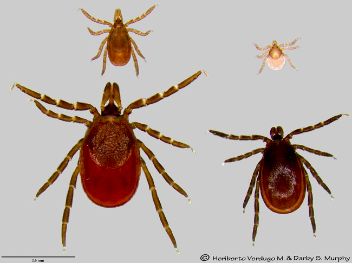I recently read an article in Field Notes, newsletter of the Southwest Wisconsin CWD, Deer and Predator Study. In the article, researchers continue to look for ways that CWD spreads through a population. Dr. Inzalaco, at UW-Madison realized that one of the most common social behaviors among deer, allogrooming, could be facilitating CWD exposure and transmission. Allogrooming is where deer groom each other to help remove ectoparasites, especially from hard-to-reach areas like the back of the neck and ears.
 While deer can transmit CWD directly through saliva during these grooming sessions, Inzalaco zeroed in on the purpose for deer to groom each other: to remove ticks. During allogrooming, deer can consume the ticks and tick blood meals. Blood from a deer with CWD contains infectious prions and naturally ticks ingest a lot of blood. “That’s what is concerning – how much blood [the ticks] take up and how long they stay attached. Couple that with white-tailed deer’s grooming of one another, and you have two important factors that we need to consider. Ticks may be a mechanical vector for transmission of CWD,” said Dr. Inzalaco.
While deer can transmit CWD directly through saliva during these grooming sessions, Inzalaco zeroed in on the purpose for deer to groom each other: to remove ticks. During allogrooming, deer can consume the ticks and tick blood meals. Blood from a deer with CWD contains infectious prions and naturally ticks ingest a lot of blood. “That’s what is concerning – how much blood [the ticks] take up and how long they stay attached. Couple that with white-tailed deer’s grooming of one another, and you have two important factors that we need to consider. Ticks may be a mechanical vector for transmission of CWD,” said Dr. Inzalaco.
Dr. Inzalaco used a special blood test to determine if black-legged (deer) ticks can take in prions from infected blood. The test showed that ticks take in prions from CWD infected blood and excrete them.
 She then collected feeding ticks from 175 wild harvested deer heads, of which 15 deer were positive for CWD. Three of the CWD-positive deer heads also contained CWD-positive ticks with transmission-relevant levels of CWD prions. “This study shows that blood is important when we consider the implications of social grooming behavior among deer, suggesting that ticks could play a role in transmission,” said Inzalaco. More research will need to be conducted to determine if these findings play a role in passive transmission of CWD.
She then collected feeding ticks from 175 wild harvested deer heads, of which 15 deer were positive for CWD. Three of the CWD-positive deer heads also contained CWD-positive ticks with transmission-relevant levels of CWD prions. “This study shows that blood is important when we consider the implications of social grooming behavior among deer, suggesting that ticks could play a role in transmission,” said Inzalaco. More research will need to be conducted to determine if these findings play a role in passive transmission of CWD.
Even if you aren’t a deer hunter, chronic wasting disease (CWD) in white-tailed deer may impact you. Chronic wasting disease is a fatal, infectious nervous system disease of deer, moose, elk and reindeer/caribou.
It belongs to the family of diseases known as transmissible spongiform encephalopathies (TSEs) or prion diseases. CWD occurs only in members of the cervid or deer family — both wild and captive.
The Wisconsin DNR began monitoring the state’s wild white-tailed deer population for CWD in 1999. The first positives were found in 2002 from the 2001 hunting season. Hunters killed three CWD-positive deer in western Dane County during that season. It has also been found in Wisconsin’s captive deer populations whether on deer farms or hunting ranches.
The US Geological Survey’s National Wildlife Health Center reported by the end of the 2022 sampling season, nearly 11,000 CWD-positive deer had been detected in 41 Wisconsin’s counties. Currently, only about 1/3 of Wisconsin’s counties either have not detected a CWD infected deer or are not on the “watch” list meaning they are within 10 miles of a CWD positive detection.
A Quick Review of CWD in Wisconsin
Chronic wasting disease is a fatal, infectious nervous system disease of deer, moose, elk and reindeer/caribou. It belongs to the family of diseases known as transmissible spongiform encephalopathies (TSEs) or prion diseases. CWD occurs only in members of the cervid or deer family — both wild and captive.
The Wisconsin DNR began monitoring the state’s wild white-tailed deer population for CWD in 1999. The first positives were found in 2002 from the 2001 hunting season. Hunters killed three CWD-positive deer in western Dane County during that season. It has also been found in Wisconsin’s captive deer populations whether on deer farms or hunting ranches.
The US Geological Survey’s National Wildlife Health Center reported by the end of the 2022 sampling season, nearly 11,000 CWD-positive deer had been detected in 41 Wisconsin’s counties. Currently, only about 1/3 of Wisconsin’s counties either have not detected a CWD infected deer or are not on the “watch” list meaning they are within 10 miles of a CWD positive detection.
Learn more about CWD.
Ticks & CWD
Researchers continue to look for ways that CWD spreads through a population. Dr. Inzalaco realized that one of the most common social behaviors among deer, allogrooming, could be facilitating CWD exposure and transmission. Allogrooming is where deer groom each other to help remove ectoparasites, especially from hard-to-reach areas like the back of the neck and ears.
While deer can transmit CWD directly through saliva during these grooming sessions, Inzalaco zeroed in on the purpose for deer to groom each other: to remove ticks. During allogrooming, deer can consume the ticks and tick blood meals.
Blood from a deer with CWD contains infectious prions and naturally ticks ingest a lot of blood. “That’s what is concerning – how much blood [the ticks] take up and how long they stay attached. Couple that with white-tailed deer’s grooming of one another, and you have two important factors that we need to consider. Ticks may be a mechanical vector for transmission of CWD,” said Dr. Inzalaco.
Dr. Inzalaco used a special blood test to determine if black-legged (deer) ticks can take in prions from infected blood. The test showed that ticks take in prions from CWD infected blood and excrete them.
She then collected feeding ticks from 175 wild harvested deer heads, of which 15 deer were positive for CWD. Three of the CWD-positive deer heads also contained CWD-positive ticks with transmission-relevant levels of CWD prions. “This study shows that blood is important when we consider the implications of social grooming behavior among deer, suggesting that ticks could play a role in transmission,” said Inzalaco. More research will need to be conducted to determine if these findings play a role in passive transmission of CWD.

